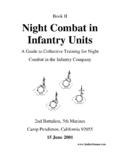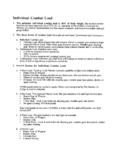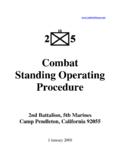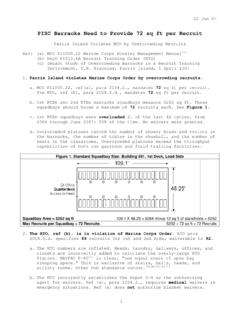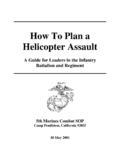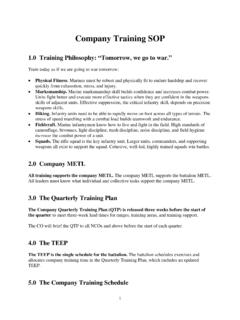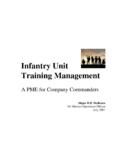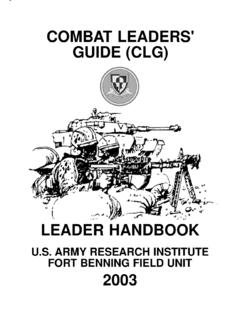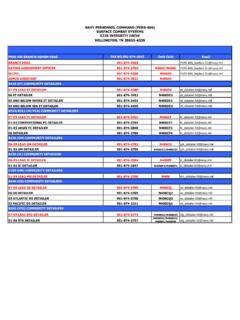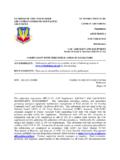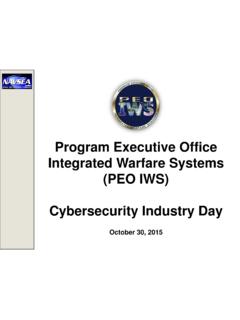Transcription of Close Combat Marine - Advisor Home
1 Close Combat Marine Workbook Marine Corps Institute May 2002 Table of Contents Foreword Close Combat and Learning Infantry Tactics ivIntroduction How to use this Workbook viiModule 1 CONTROL of FIRES 1 Fight 1-1 Urban Contact 3 Module 2 BOUNDING OVERWATCH 5 Fight 2-1 Secure the Airfield 6 Fight 2-2 Down on the Farm 8 Module 3 Infantry DEFENSE 10 MACHINEGUN Defense in Urban Terrain 12 Fight 3-1 Urban Defense 14 Module 4 ANTI-TANK Tactics for Infantry Units 16 Fight 4-1 The Wadi 18 Fight 4-2 Bridge Defense 20 Module 5 The Infantry ASSAULT 22 Fight 5-1 Attack on the Bank 23 Module 6 The Infantry ATTACK 25 SBF Tactics 26 Fight 6-1 Convoy Rescue 27 Fight 6-2 On the Beach 29 Fight 6-3 Attack on the Village 31 Module 7 MORTAR Tactics in Open Terrain 33 MORTAR Techniques 34 Fight 7-1 The Hairpin Turn 35 Fight 7-2 Close on the Town 37ii Module 8 MECHANIZED INFANTRY 39 Fight 8-1
2 Seize the Airfield 40 Fight 8-2 Ambush React Force 42 Appendix A Thoughts on Verbal Orders 44 Appendix B Orders Shorthand 50 Appendix C Glossary 52 iii Foreword Close Combat and Learning Infantry Tactics I have learned more about small-unit infantry tactics from the Close Combat simulation than I have from fourteen years of Marine Corps infantry experience. Close Combat is a computer Combat simulation published by Atomic Games. The focus of the simulation is on infantry Combat at the small-unit level.
3 The series currently consists of five versions: Close Combat I: Omaha Beach, II: A Bridge Too Far, III: The Russian Front, IV: Battle of the Bulge, and V: Invasion Normandy. I am an infantry major with fourteen years commissioned service, seven years with 5th marines , three years in schools, and three years as an infantry training officer with the Marine Corps Warfighting Lab. I have deployed overseas with 2nd Battalion, 5th marines four times. I have commanded two infantry platoons and one rifle company. I have served as a battalion operations officer and regimental operations officer.
4 I am a student of tactics. I have taught NCOs and officers infantry tactics. I have participated and led tactical decision training. None of these activities or learning experiences can match the effective and focused tactical learning that I have experienced through repetitive fighting of the small unit scenarios in Close Combat . Close Combat permits a player to fight hundreds of scenarios, make thousands of tactical decisions, experiment with different tactics, and learn from his mistakes. I would be a far more qualified platoon commander now than I was twelve years ago.
5 Through fighting the Close Combat simulation, I have internalized significant platoon-level tactical lessons: Long unsupported assaults are deadly. Assault for short distances, against a lightly armed or well-suppressed position. A single enemy soldier can destroy a squad across 100 meters of open ground. A long covered approach is always better than a short open route. Be careful of covered approaches that cannot be covered by an overwatching unit. Every unit needs obscuration. Smoke save lives. Every assault and every withdrawal should use smoke.
6 Fire and maneuver is the key tactic. Use the majority of your force to overwhelmingly suppress the enemy, and a small assault unit to rapidly Close on the objective. iv It's all about suppression. Fire without maneuver is wasteful and indecisive. Effective suppression is the basis for all infantry tactics. Units without mutual support are doomed. Mutually supported units protect each other from being fixed or assaulted. Mortars are inherently inaccurate. Area suppression is NOT destruction. Rounds are limited.
7 Use them well. Don t waste mortars on bunkers or buildings. Concentrate your fire. Fire control insures decisive action. In contact, men will disburse their fire. Sequentially destroying targets with point fire is more effective than distributing ineffective fires. Every unit squad, platoon, and company needs antitank capability when facing tanks. An infantry unit with no organic antitank weapon is either retreating or overrun. Tanks can only be fought in Close terrain. For anti-tank positions, deep and narrow sectors of fire with defilade on both sides are best.
8 The best sector of fire allows you to engage only one tank at a time. Defensive positions are temporary. All units need multiple positions and the ability to withdraw. For machinegun positions, deep and narrow sectors of fire, with defilade on both sides, are best. Primary and secondary sectors separated by frontal protection are better. Cover is life. Move from one covered position to another. Good cover is relative to a single enemy position. Mutually supporting enemy positions can overcome the protection of your cover.
9 Use bounding overwatch to move. A squad in contact needs immediate suppression from another unit. The measure of success is the number of units that can immediately bring suppression to bear upon enemy contact. Good Marine leaders know all of these lessons. They have been taught, they have read, they have trained to do them. But I, and those marines who have fought Close Combat , know these lessons in our bones. We know the penalty for mistakes, for misreading the situation, for making decisions too late. Hundreds of simulated men have died in botched assaults, poorly laid positions, and as a result of unexpected enemy actions in order to teach these lessons.
10 We have examined the ground, checked the line-of-sight, positioned the units, and supervised the units in contact so many times that the key tactical principles have become ingrained as second nature. I have defended three hundred road intersections. Not just the first step of putting a defensive scheme on paper, but all the way through to initiation of Combat , falling back to secondary positions under pressure, and sometimes being overrun by the enemy because I failed to protect my machine gun positions. I cannot walk across a street now without seeing in my mind the intersection occupied: An anti-tank weapon tucked into that low position with an oblique field v of fire and good defilade, machineguns here and here, one squad forward with a alternate position near the guns, one squad on the corner in case they put infantry down that alley.
